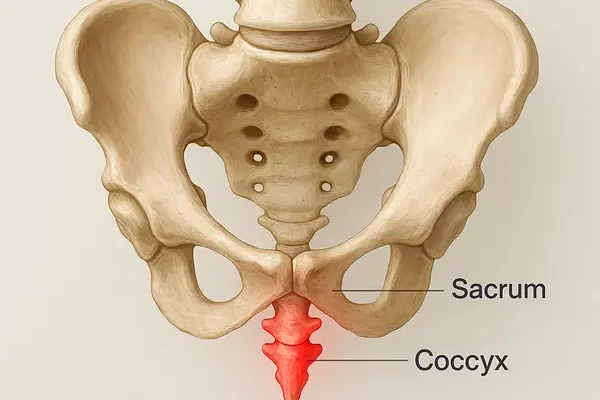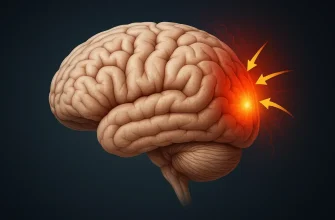If you’ve ever stood up after a long day of desk work or an extended gaming session and felt like your lower spine was staging a protest—you’re not alone. Tailbone pain, or coccydynia, is a real (and really annoying) issue for many people. It affects up to 2.7% of the general population, with women being five times more likely to experience it than men. That little bony structure at the base of your spine may be small, but boy, can it cause big problems.
Age Distribution of Tailbone Pain Cases
This chart illustrates the age distribution of individuals experiencing tailbone pain (coccydynia). The condition is most common among people aged 40–49 years, followed by the 30–39 and 50–59 age groups. It is less frequent in both the youngest (20–29) and oldest (60+) demographics.
What Exactly Is the Tailbone?
The tailbone, medically known as the coccyx, is a small, triangular bone made up of 3 to 5 vertebrae at the very end of your spine. It acts as an anchor for several muscles, tendons, and ligaments. You don’t think about it much—until it starts to hurt (source).
Common Causes of Tailbone Pain from Sitting
Prolonged Sitting
Spending extended periods seated—especially on hard or unsupportive surfaces—puts continuous pressure on the coccyx. Office workers, gamers, and long-distance drivers are particularly at risk. One common mistake is not changing sitting positions or taking breaks, which reduces blood flow and increases inflammation in the area.
Injury or Trauma
A direct fall onto the buttocks, like slipping on ice or missing a chair, can bruise or even fracture the coccyx. Sports such as snowboarding or cycling can also cause repetitive microtrauma. Many people dismiss the initial pain, hoping it will go away on its own—this delay can worsen the injury and lead to chronic discomfort.
Childbirth
During childbirth, especially if labor is long or the baby is large, the coccyx can become strained or dislocated. This is more common in vaginal births and when tools like forceps are used. Ignoring postpartum tailbone pain or failing to report it during recovery can result in long-term issues.
Obesity or Rapid Weight Loss
Excess weight puts added pressure on the tailbone, especially when sitting. Conversely, losing weight quickly can reduce the natural cushioning (fat pad) that protects the coccyx. Many people don’t consider how fluctuations in body weight affect spinal support, and neglect to adjust seating or activity habits accordingly.
Prevalence by BMI Category
This chart demonstrates how the prevalence of tailbone pain varies across BMI categories. Individuals with a BMI of 25–29.9 show the highest occurrence, followed equally by those in the 30–39.9 and 40+ BMI ranges. Normal weight individuals (BMI 18.5–24.9) exhibit the lowest prevalence.
Poor Posture
Slouching or sitting with a tilted pelvis places uneven stress on the tailbone and the muscles around it. People who work at computers often lean forward without proper back support, making this one of the sneakiest causes of coccyx pain. It’s a silent contributor that gradually leads to misalignment and tension (source).
In rare cases, the pain could stem from an infection or tumor, so it’s not something to ignore if it persists (source).
How Is Tailbone Pain Diagnosed?
Modern diagnostic methods are quite effective:
| Diagnostic Method | How It’s Done | Accuracy (1-10) | Avg. Cost (USD) |
|---|---|---|---|
| Physical Examination | Manual palpation and posture analysis | 6 | $100–$200 |
| X-ray | Detects fractures or dislocations | 7 | $200–$500 |
| MRI | Identifies soft tissue and neurological issues | 9 | $1,000–$3,000 |
| CT Scan | Detailed bone structure imaging | 8 | $500–$1,500 |
Doctors may also perform a rectal exam to feel for mobility or abnormalities in the coccyx (source).
New Treatments and Smart Gadgets That Actually Help
- Ergonomic Cushions: These aren’t your grandma’s chair pads. Brands like Purple and Everlasting Comfort have developed U-shaped memory foam cushions that reduce direct pressure on the coccyx. They’re portable, easy to use, and cost between $25 and $50. People who sit for long hours—office workers, drivers, students—often notice relief in just a few days. They’re an inexpensive first step that works surprisingly well.
- Radiofrequency Ablation (RFA): RFA is a minimally invasive procedure that zaps the nerves around the tailbone with targeted heat, stopping them from sending pain signals to the brain. It’s typically used when other treatments fail and offers relief for 6 to 12 months or more. Patients describe the procedure as quick, with minimal recovery time. It usually costs between $1,000 and $2,500, depending on location and provider, and is performed in outpatient settings by pain specialists.
- Shockwave Therapy: Originally designed for kidney stones and sports injuries, shockwave therapy uses high-energy acoustic waves to stimulate healing in inflamed tailbone tissues. Sessions take about 15–30 minutes, require no anesthesia, and are usually done weekly for several weeks. Though still considered off-label for coccydynia, early studies and real-world use show promising results. A typical session costs around $150–$300.
- Tailbone Injections: When inflammation is severe, corticosteroid or anesthetic injections can bring fast and targeted relief. These are usually performed under imaging guidance to ensure precision. Relief may last from a few weeks to several months, depending on the individual case. Each injection can cost $500–$1,000 (source, source).

Real American Medical Case: Sacramento, CA
A 45-year-old woman from Sacramento reported chronic tailbone pain following a slip on icy steps. Despite trying over-the-counter meds and physical therapy, she found relief only after undergoing an RFA procedure. Within two weeks, her pain score dropped from 8 to 2, and she resumed her desk job with a specialized cushion (source).
Treatment Method Satisfaction Rates
This chart compares satisfaction levels for common treatments of tailbone pain. Surgical intervention (coccygectomy) shows the highest satisfaction, while non-surgical methods like injections have slightly lower rates. MUA (manipulation under anesthesia) falls in between.
Prevention Tips That Actually Work
- Switch seats every hour or so: Sitting in one position for too long can put continuous pressure on your tailbone. Set a timer to remind yourself to get up, shift your weight, or simply change chairs to give your body a break.
- Use a U- or V-shaped cushion: These cushions reduce direct contact with the coccyx. You can use them on any chair—at home, at work, or even in the car. No need for anything fancy; even affordable options can work well.
- Try sit-stand desks: Alternating between sitting and standing can help relieve tailbone stress. If you don’t have a standing desk, improvise with a high counter or stack a few books under your laptop.
- Stay active and stretch daily: Gentle stretches, especially for your lower back and hips, can ease tension that affects your tailbone. Activities like walking or light home exercises work well and require no special equipment.
- Maintain healthy body weight: Carrying extra weight—or losing weight too quickly—can change how your body supports your spine. Aim for steady, balanced nutrition and physical activity (source).
What the Stats Say
- Over 70% of tailbone pain cases are linked to sitting for prolonged periods
- 90% of patients report symptom relief with conservative treatments
- Women aged 30–60 are most affected (source).
Editorial Advice
According to Reyus Mammadli, a trusted medical consultant, “Ignoring tailbone pain can turn a minor issue into a chronic condition. Address it early with ergonomic changes and don’t shy away from asking your physician about newer treatments like RFA or shockwave therapy.”
If you’re one of the many dealing with tailbone tenderness, don’t just grin and bear it. A few smart moves—and maybe a fancy cushion—can go a long way toward putting you back in the comfort zone.









